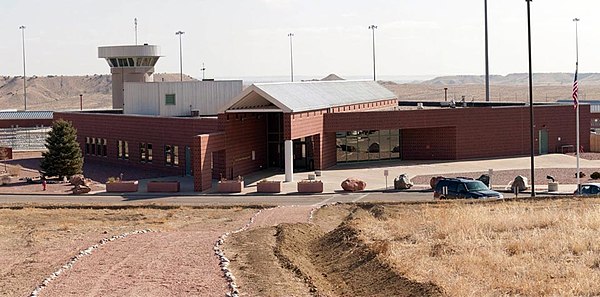7.10. Prison Levels
David Carter and Kate McLean
Different prison jurisdictions – state, federal, etc. – are also distinguished by varying degrees of supervision intensity – roughly matched to the “dangers” or criminogenic needs presented by the offenders housed therein. These are reflected in prison levels or classifications. Many States have three classification levels: minimum, medium, and maximum. Some States have a fourth level called super-maximum. Others call this level “close”, or “administrative” level. The BOP has five levels: minimum, low, medium, high, and unclassified. (The most serious offenders at the federal level are housed in an “unclassified” facility, ADX Florence, located near Florence, Colorado.) Although not in operation today, Alcatraz served as a de facto “super-max” within the federal BOP at point, housing the most infamous federal inmates. Consider the two images – of Alcatraz and ADX Florence – below. How are they similar? Different?
Alcatraz Island, ca. 1934

ADX Florence, ca. 2010

Other states use a simple number designator to describe prison intensity, such as Level I, Level II, Level III, Level IV, and sometimes Level V. Finally, some states also operate “Camps,” a type of low-level designation often assigned a specific purpose. For example, “Fire Camps” are dedicated to fighting fires. While taking different names, here are the qualities that generally characterize prisons at different levels of supervision.
Minimum/Level I – These prisons usually have dorm style housing, and are typically reserved for non-violent offenders, with shorter sentences (or sentence lengths left, after downgrading from another facility). The fencing or perimeters at Minimum Security facilities are usually low. The BOP sometimes refers to these as “camps”.
Low/Level II – These types of prisons are similar to “minimums”, including some kind of dormitory-style housing. However, there are normally more serious or disruptive offenders in these types of prisons. The fencing around the perimeter is generally higher, and maybe even doubled. Offenders are typically in these institutions for longer periods.
Medium/Level III – Here, there is a transition from dorm-style housing to cells. Normally, there are two persons to a cell, but not always. The perimeter is usually a high fence/barbed wire, or large walls surrounding the institution. Freedom of movement within the institution is reduced, and seen as privilege. Inmates here typically longer sentences, and include violent convictions.
High or Maximum/Level IV – Similar to medium, but most offenders have violent convictions and longer sentences, including life. Many individuals will spend most of their day in a cell; more often than not, cells are single occupancy.
Super-Max or Administrative Control/Level V – Depending on what the mission is for a particular prison, the prisoners in these institutions could be vastly different. For instance, if it is a facility that is designated for individuals with severe mental health illness, it would not operate the same as one that is not. The super-max facilities would have individuals in their cells for almost all of every day. Many services would come to them at their cell, with cells almost all be single occupancy. Visitation of these inmates would be much more regimented and monitored. Most of these individuals are also classified as extreme threats to the successful operations of the prison and are long-term inmates (LWOP – life without the possibility of Parole).
Intake Centers – An intake center can be part of an institution, running alongside its normal operations. The purpose of an intake center is to classify offenders coming from the various courts in the jurisdiction, post-felony conviction. The offender has an initial classification, where they are getting assigned to one of the jurisdiction’s prisons, based on a point system for that agency. This assessment is looking at priors, prior and current violence, escape risk, and potential self-harm. Inmates will gain later classifications at their destination prison, in terms of work assignments, mental health status, cell assignments, and other items.

